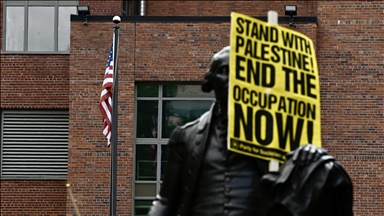
HOUSTON, Texas
Americans are struggling to make ends meet, with prices at the gas pump nearly double what they were a year ago while the cost of groceries and household items has skyrocketed.
"Everyday goods and services are priced out of most people's reach," said Davis Brookman, a resident of Dayton, Ohio, who told Anadolu Agency she's trying to get by with the limited income she makes.
"Rapidly rising prices are harming American families, eroding the value of paychecks and increasing the financial strain of buying everyday goods like groceries and gasoline," she added.
The current rate of inflation in the US is 9.1%, the highest in 40 years, and when inflation goes up, so do prices, making it hard for people to afford everyday goods and services and giving them sticker shock when they go to the store.
"What makes it harder for Americans is the amount of money they need to afford something when the prices are going up," said Jorge Barro, a fellow in public finance at Rice University's Baker Institute for Public Policy.
"The difficulty is that if your income is fixed, if your salary is fixed, if your wage is fixed and not rising at the same rate as inflation, then your real income -- or inflation-adjusted income -- can go down," Barro told Anadolu Agency. "When your real income goes down, it erodes your purchasing power and you can't afford to consume as much, given your income and savings you had before inflation."
Barro said people with low and fixed incomes are probably struggling during this spike in inflation but emphasized that it is a little bit unique as we push into two and a half years of the coronavirus pandemic.
"The income of low-income households had increased significantly during the start of the pandemic between stimulus checks and increased wages," said Barro. "The wages of low-skilled jobs such as delivery drivers went up because we had a large restructuring of the economy in which people switched significantly away from services and towards goods, and that disrupted a very long-term trend in the US."
In addition, Barro said more people spent time at home during the beginning of the pandemic and that "you painted your house instead of hiring a painter because people had extra time on their hands."
"At the start of the pandemic, there was a sharp increase in the wages of low-skilled workers, many of whom were lower income, and the increase in their wages had outpaced inflation," he said. "Now that we're having post-pandemic inflation, there are a lot of low-income earners that came out with a net improvement despite the current inflation spike."
Unfortunately, the same can't be said for the "old and poor" in many communities.
"For true low-income retirees, when you're retired, there's very little you can do to adjust your earning potential because you're getting just social security or retirement income, so they're going to be more reliant on social security," said Barro.
"There was roughly a 6% increase in the social security payments for this year, but the increase was not sufficient enough to offset the current inflation rate," he added. "So if you have 9% inflation and a 6% adjustment, then you're at a 3% loss, which means inflation is outpacing the increase in social security payments."
"Personally, I have a lower income to catch up on my bills and I spend a higher portion than I earn," said Brookman. "Inflation is also eroding the value of savings, making it harder for Americans to build wealth."
Barro said the high inflation rate is a combination of several factors. On the demand side, many Americans received pandemic-related stimulus checks and the Federal Reserve kept interest rates low for a long time by pumping money into the system.
On the supply side, he said there were supply chain issues and worker shortages, in addition to a greater number of people retiring early or some of them never returning to work at all.
If it hadn't been for the Russia-Ukraine war, which began nearly six months ago, Barro believes inflation may have already peaked in the US.
"The consequences of the Ukraine war did contribute to a spike in oil and gas prices," he said.
In July 2021, the average price for gas at the pump in the US was $3.16 per gallon.
In July 2022, the cost of a gallon of gas was $4.56.
Overall, the increase in gas is up 40%-60% over the past year.
"It pretty significantly affects you at the pump," said Barro. "You can cut back on driving and reduce your gasoline demand, but it's very difficult to make significant adjustments to transportation over shorter periods. The things you can't cut out -- trips to the grocery store and trips to work -- those are fixed trips in the short run."
Despite the ongoing war in Ukraine, Barro believes there is still a strong sense we may be close to the peak of inflation.
"Because the increase in prices is starting to decline," he said. "Prices may not go back down, but the rate of the increase might go down, which determines inflation."
While many Americans are feeling the pinch of inflation in their wallets and tightening their belts to make it through this spike in prices, there appears to be light at the end of the tunnel.
"Some prices have stabilized," said Barro. "We see gasoline starting to tick down, some food prices have stabilized, and the Federal Reserve is aggressively increasing rates to slow the economy down with the goal of reducing the inflation rate."








